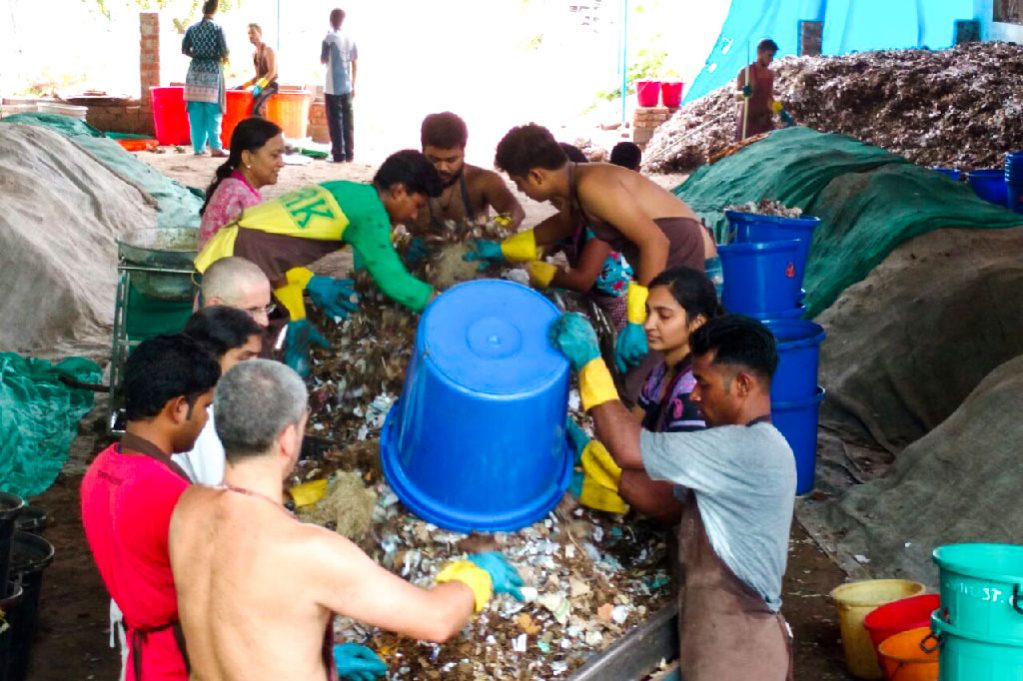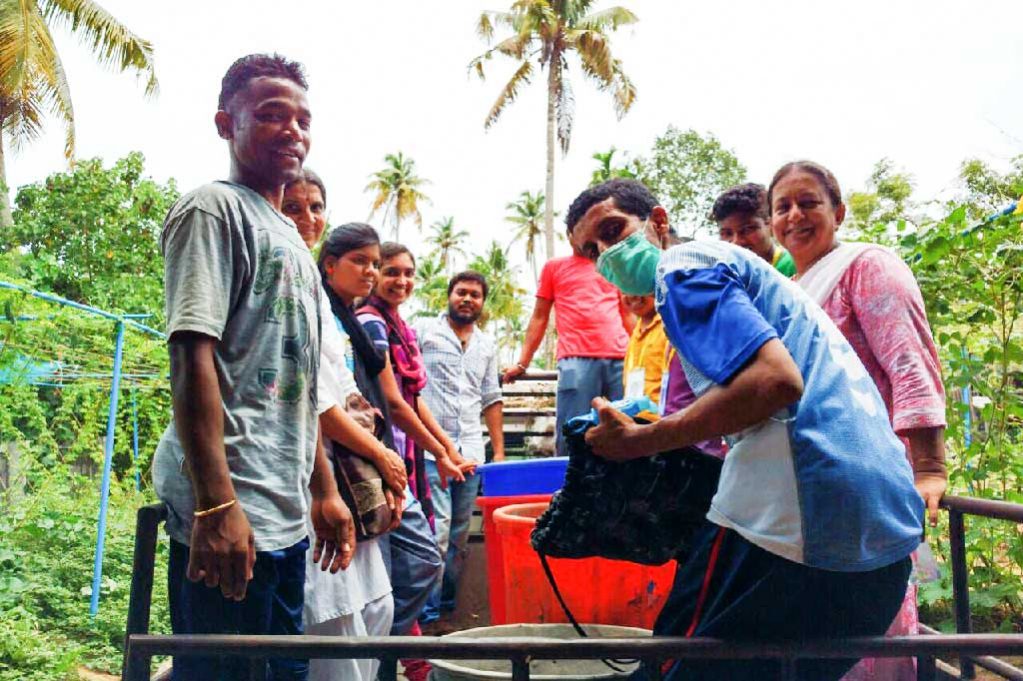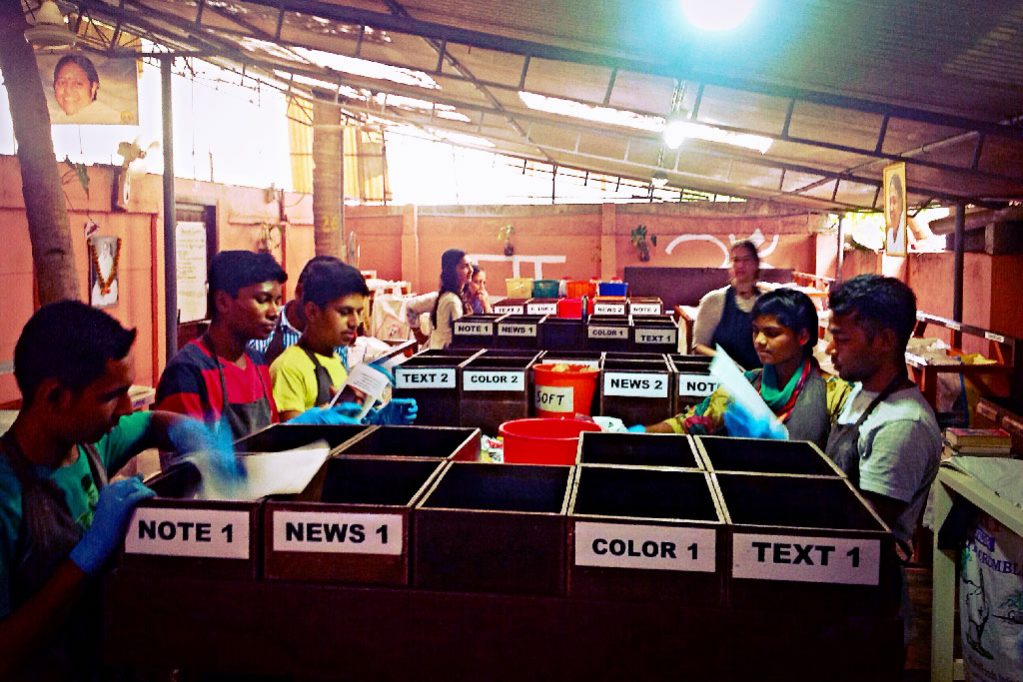FEATURES
How to Clean our Oceans?
Amrita SeRVe’s first course in Waste Managment
June 2016
“I like the ponds, and I feel connected to them the most in nature,” answered one young man during Amrita SeRVe’s first Waste Management Course held in Amritapuri, May 2016.
The students were asked, “What is everyone’s favourite thing about nature? What opens your heart? What connects you to nature the most?”
More answers came straight from the heart: “I love the river flowing.” And the followup, “To see when the horizon meets the river.”
Everyone shared their insights, “I love the morning sun, and how it resonates to initiate new beginnings.”
There were seven students who travelled to Amritapuri from our Gujarat and Jharkhand villages. They came because they wanted to learn how to respond to the enormous task of taking care of their villages from the waste management point of view.
Shivanand, who came from Jharkhand to take part, asked, “What is waste? How can we dispose of this waste? Segregate and get income from the waste?”
He told what he wanted to do, “Creating awareness is a first step for anything we do in the villages. Also, I’m going to spread that knowledge to nearby villages.”
When he told Amma about his ideas, she said to him, “Do it sincerely, and you will succeed.”

The course, inspired by Amma, was the first one of its kind in Amritapuri. Mahita Goris is in charge of Amritapuri’s recycling centre and many years earlier, Amma asked her to develop a model of waste management that can spread across the country. A central issue of the need of waste management is climate change. Mahita explained:
“Our mother is our Earth, and just like any good mother, she is always watching over us to care for us and to protect us and give us what we need to grow and sustain in a happy, fulfilling life. She provides the rain to nurse the crops, she provides the sun so they can grow. She provides the cool season to bring relief when the temperature is too hot. And she brings us all the seasons of our lives to grow our food, to build our shelters, and to take care of our needs.”
Mahita said that the content of which she spoke was inspired by reading scientific facts and hearing Amma’s teachings. She explained, “Amma said that a mother only wants to take care of her children, and a mother never wants to punish her children. But often, they wind up punishing themselves based on their actions.”
Mahita explained that the Earth Mother gives to her children through the weather, and she sees her children’s needs by the messages carried in the water. But we have blocked her vision through improper waste management.
“And so she is rubbing her eyes in the course of trying to see, and she can’t see properly. She has to send too much water or not enough,” continues Mahita. “Or too much earth shifting, earthquakes—all the things that have been the result of the fact that we’ve made her blind. And she has lost her balance and her ability to take care of us because of our own actions.”

Photo by Chris Jordan (via U.S. Fish and Wildlife Service Headquarters).
As an example of the urgency of the issue, India generates 5.6 million metric tons of plastic waste per year, according to a 2013 report from the government’s Central Pollution Control Board (CPCB). CPCB was asked to study plastic waste generation by India’s Supreme Court, and when CPCB submitted the findings, the Supreme Court stated, “We are sitting on a plastic time bomb.”
The global need for such endeavours can be understood upon first hearing about something called “The Great Pacific Garbage Patch” in the North Pacific Ocean. A gyre is a system of large rotating ocean currents, especially those involved with huge wind movements.
The gyre in this location is filled with waste that has been caught in the spiralling water—an estimated six kilos of plastic for every kilo of plankton. The garbage patch itself is estimated to be nearly 800 square kilometres—the same size as the country of Turkey.
Around the world, according to the United Nations Environment Programme, plastic is killing a million seabirds and 100,000 marine mammals and turtles per year. Sometimes, the animals are caught in discarded, plastic fishing lines and nets. Other times, they choke or have digestive tracts clogged by bottle caps, pocket combs, cigarette lighters, cotton bud shafts, toothbrushes, toys, syringes, plastic shopping bags and many other such things.

Fully aware of the pressing need to educate about how to manage our waste, Mahita modelled the content of the course via hands-on work in the morning. Then in the afternoon came explanations of the significance of the actions done.
“They would take an initiative,” explained Mahita. “They would get their hands involved and then their minds. Then I was able to talk about compost, carbons and nitrogen, and green versus dry.”
Actual practical work included recycling, segregating waste, composting, and maintaining cleanliness of private and public areas. The scale of work went from management at the household level to that of the entire village. Also, an income generation aspect was taught in terms of how waste can be reused and actually be a source of earnings.
“In one of the early practical sessions, Fulmani, a girl from Jharkhand, separated a written notebook from its cover moulded from plastic and paper and put things in their respective sections without being told,” recollects Sreeranjini, one of the course coordinators. “Seeing this, Mahita was very happy as the villagers are getting the idea of separation of waste even before her teaching it.”

The students certainly were inspired and they want to do something about it. Raju said, “I did not know what was waste management before, so I came to see what it is.” He explained he learned a lot and will begin waste management practices as soon as he gets home.
Courses like this one in waste management for India’s villages could be a beginning to collectively find a solution from the grass roots level, and then this message can spread to larger communities.
According to the teachers, the students showed genuine interest towards the subjects they learned and expressed true love for nature. As Sreeranjini, a course coordinator, put it, “With Amma’s blessings, a group of confident young people with the know-hows of waste management was the result.”

Mahita, head instructor of the Waste Management Course, is in the middle.

